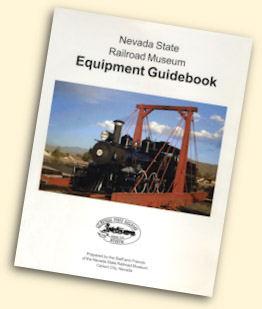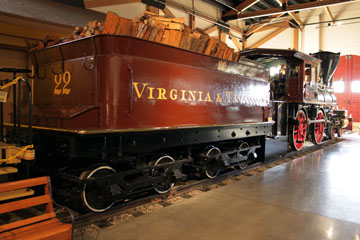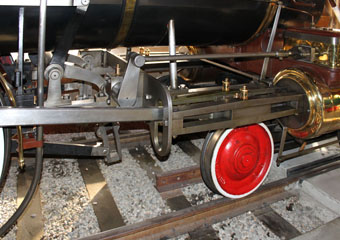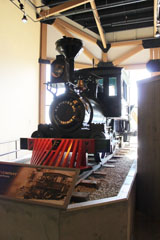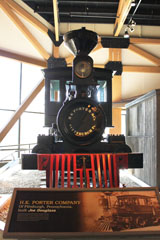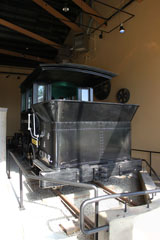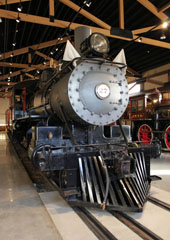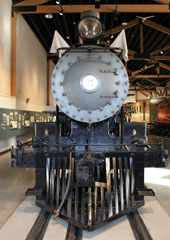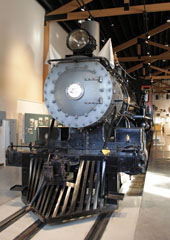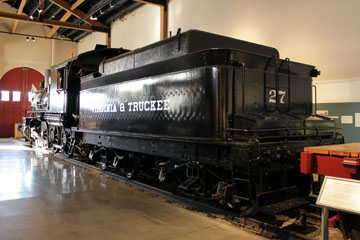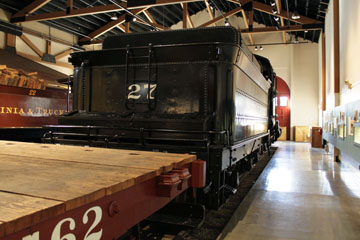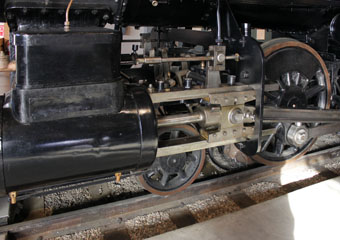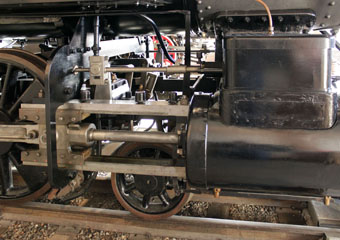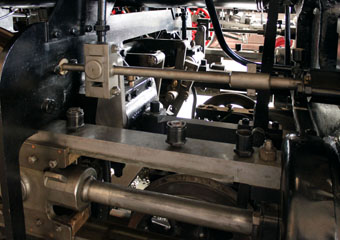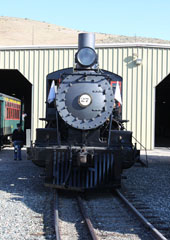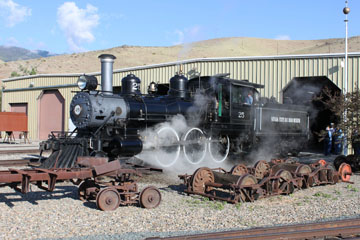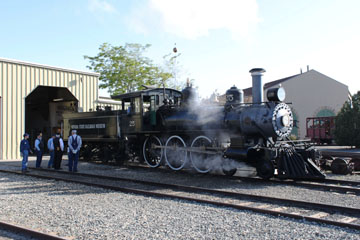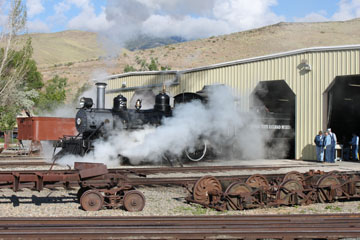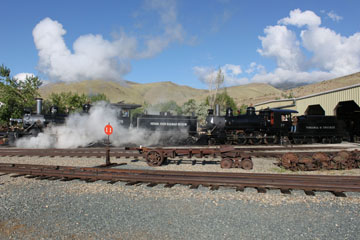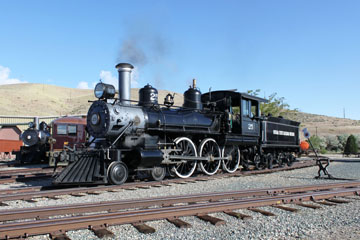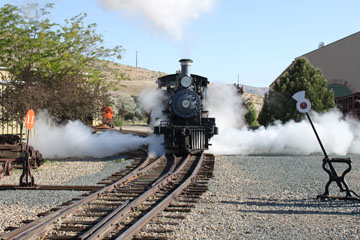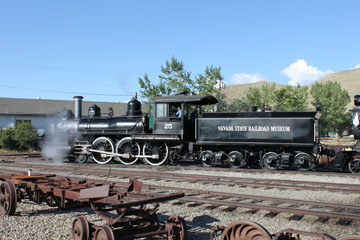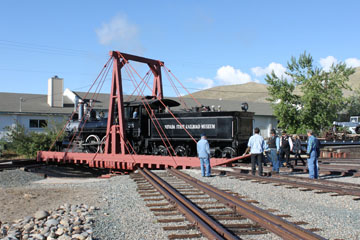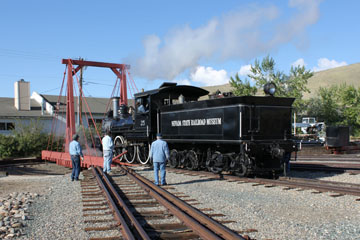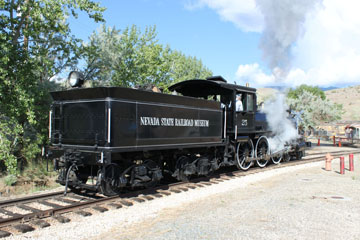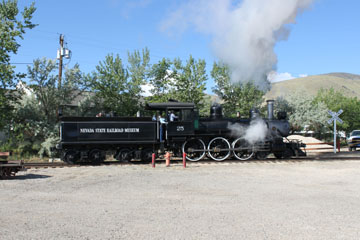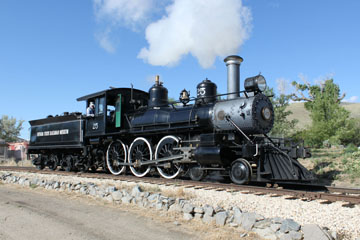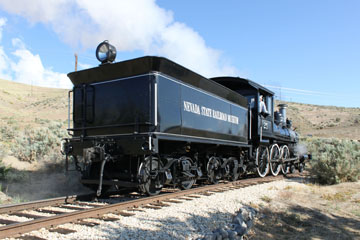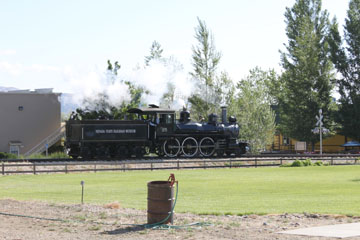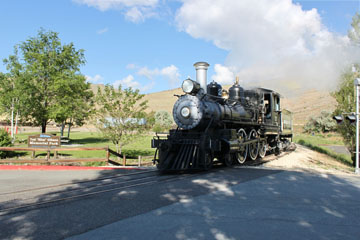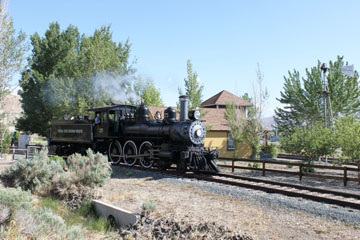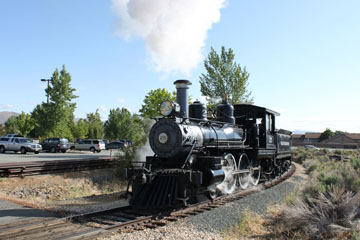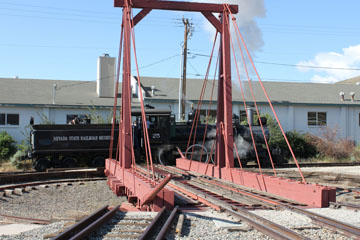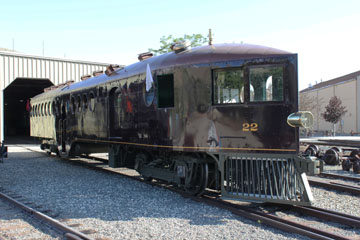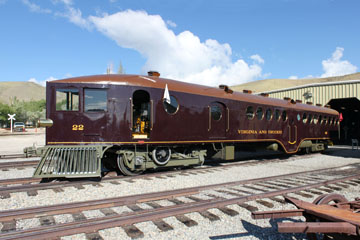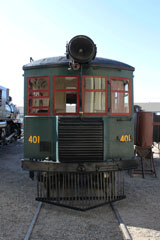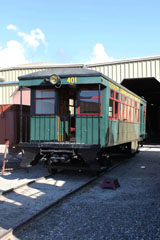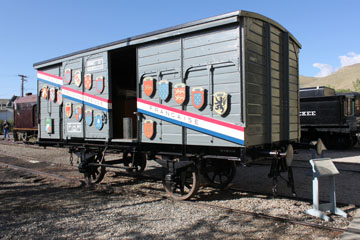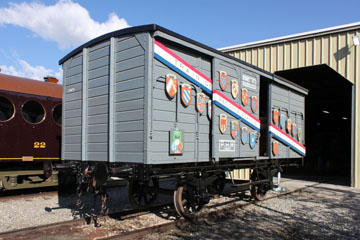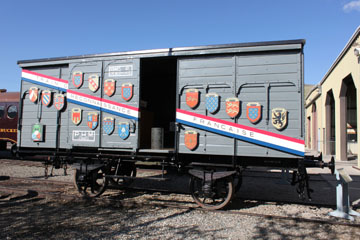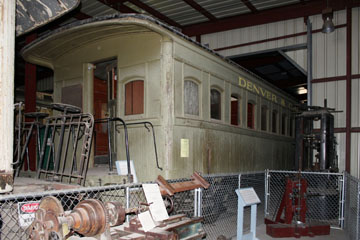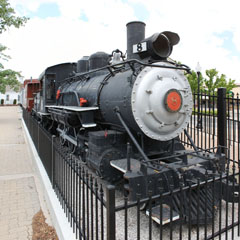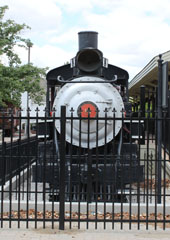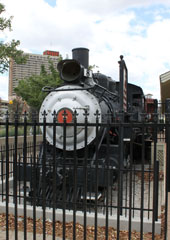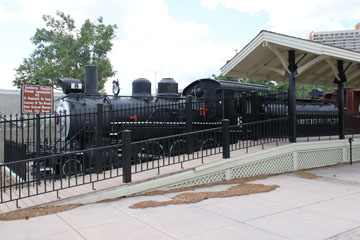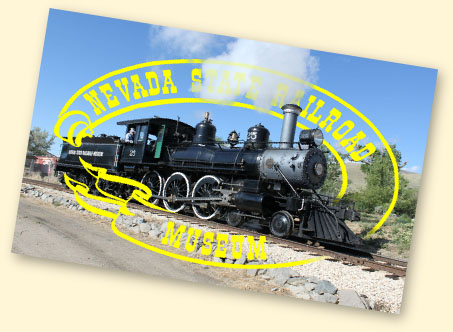

The Nevada State Railroad Museum is at 2180 Sth Carson St, Carson City, NV. It is open Friday to Monday 8.30 am to 4.30 pm except Christmas Day and New Year's Day.
The museum is staffed by volunteers from the Friends of the Nevada State Railroad Museum, who also carry out restoration work and operate the historic equipment. There are train rides on weekends during the season starting on the 1st of May and ending in early December with the Santa Train. Motive power varies from weekend to weekend, so check the schedule before making the trip if you are hoping to see live steam.
There is an opportunity to participate in the museum's "Your Hand is on the Throttle" programme, which allows one person to learn how to operate Baldwin built 4-6-0 Virginia & Truckee #25 when it is scheduled to haul trains. The museum is also noted for having the only surviving McKeen Motorcar in its collection. The car was recently restored and is now in immaculate condition. It also runs at certain times of the year.
I have visited the museum a couple of times and the photos on this page are from both visits.


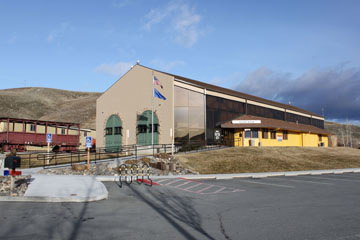
The main museum building houses static displays. When I first visited, VT #22 "Inyo" was inside, along with VT #27, and there were several carriages on display as well as a number of quite detailed models of V&T locomotives in small, glass-fronted recesses set into the walls. There is also a small, but well stocked gift shop.
There is an outside turntable and a separate engine house behind the main museum building in which other rolling stock and locomotives are housed. The second time I visited, several pieces of equipment were moved outdoors and VT #12 was steamed up (you can see photos of #12 later on this page).




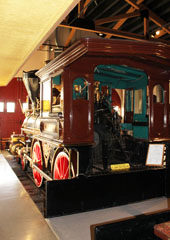
VT #22 "Inyo" is an American (4-4-0) type wood burner built in 1875 at a cost of $9,065 by Burnham, Parry, Williams & Company, an early incarnation of the Baldwin Locomotive Works. "Inyo" is a Native American word meaning "dwelling place of a great spirit", but the locomotive was soon known as "Brass Betsy" because of the great number of its brass fittings.
#22 weighs 68,000 lbs, has 57" drivers and
16" x 24" cylinders. It operated a boiler pressure of 130 psi delivering tractive effort of 11,920 lbs and could reputedly reach 60 mph.
#22 started work as the railroad’s switch engine at Gold Hill (you can see photos of VT #18 steaming through Gold Hill on the Virginia & Truckee page of this website). It then went on to haul mixed passenger and freight consists, as well as substituting for the "Reno" and "Genoa" when they were in the shop.
From the 1890s, #22 hauled the V&T’s crack Lightning Express between Virginia City and Reno, NV, with onward service to San Francisco, CA, on the Central Pacific Railroad. It was also used extensively during the Tonopah mining boom just after 1900. In 1910, it was converted to burn oil, but its days at the V&T were numbered.
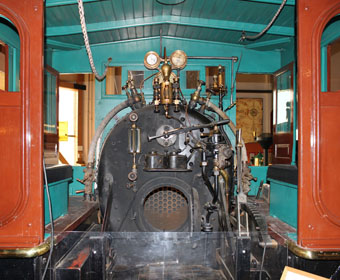
Above, a composite of the beautifully restored interior of the cab and backhead.
In 1926, #22 was retired and began to be used for spare parts for other V&T locomotives. It was rescued from gradual cannibalisation in 1937, when Paramount Pictures bought it for $1,250 to feature in the movie High, Wide and Handsome starring Randolph Scott and Irene Dunne. It subsequently appeared in many other movies, including The Texans (1938), Union Pacific (1939) along with three other V&T locomotives (#11, #18 and #21), Harvey Girls (1946), The Virginian (1946), Red River (1948), The Great Locomotive Chase (1956) and Last Train from Gun Hill (1959), as well as featuring in the 1960s television show "Wild, Wild West".
Between 1969 and 1974, #22 appeared as
Central Pacific's "Jupiter" at the Golden Spike NHS at Promontory in Utah until replaced by a replica of the original locomotive. There is a page on the Golden Spike NHS on this website, which includes a number of photographs of the replica "Jupiter" and Union Pacific #119 locomotives.
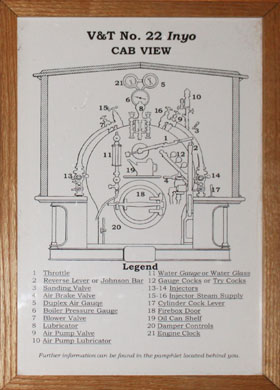
Above, a diagrammatic cab view with a key to the controls.
After serving at Promontory until 1974, "Inyo" was bought by the State of Nevada and, four years later, moved to Carson City for restoration to its
c.1893 appearance. In May 1983, it debuted at the museum, where it has been based ever since, although it has had an active career since then, participating in the grand opening of the Palace Station Casino in Las Vegas in April 1984, operating at Expo86 in Vancouver, Canada, in 1986 and at the California State Railroad Museum Railfair in 1991.
Today, #22 operates at a boiler pressure of 75 psi delivering 6,870 lbs tractive effort.
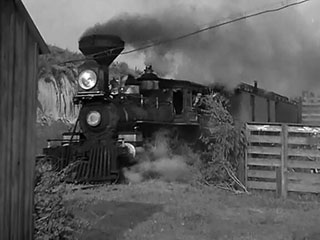
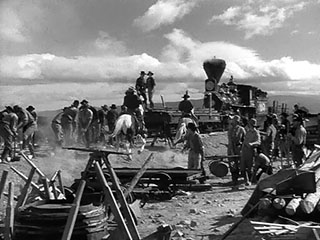
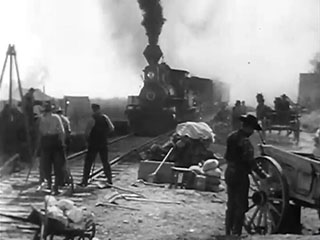
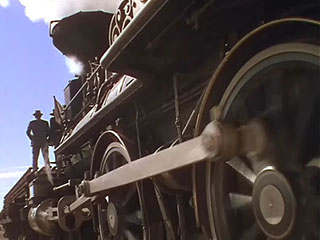
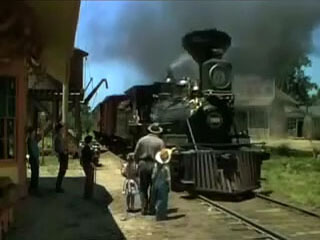

According to the museum's website, "Inyo" appeared in twenty-nine movies between 1937 and 1979, and six television programmes between 1959 and 1976.
Clockwise from top left, some of the movies in which the locomotive has appeared: The Texans (1938), Union Pacific (1939), Buckskin Frontier (1943), Duel In The Sun (1946), So Dear To My Heart (1948), Rails Into Laramie (1954) and The Great Locomotive Chase (1956).
"Inyo" starred as the Western & Atlantic Railroad's "Texas" in The Great Locomotive Chase. You can see the surviving "Texas" and find out more about this historic event on the Southern Musueum and Great Locomotive Chase page of this website.
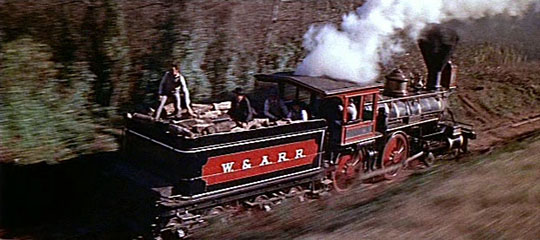

In 1900, the “Joe Douglass” was sold to the Lake Arrowhead Development Co., and shipped to California to work on the Lake Arrowhead dam. After the dam was completed in 1904, the locomotive was simply abandoned on a short stretch of track until 1947. It then went through several owners until bought by Robert Walton in 1968. He restored it to operating condition.
Walton moved to Los Altos, CA, in the mid 1970s, where he kept the “Joe Douglass” in his back yard. Concerned about the future of the locomotive, he felt it should return to Nevada.
H. K. Porter of Pittsburgh, PA, built this little 36” gauge 0-4-2T (Tank) locomotive in 1882 to work in Dayton, NV.
In 1869, J. Birdsall had built a horse drawn line from his silver tailings in Gold Canyon to a mill in Dayton. In 1882, he sold the line to J. Douglass, from whom the locomotive gets its name. Douglass incorporated the line as the Dayton, Sutro & Carson Valley Railroad. The “Joe Douglass” was the only locomotive on the DS&CV. It first steamed on 12th June 1882 and worked until the late 1890s. Maintenance and repairs were carried out by crew at V&T’s Carson City shops.

#27 double headed with #11 on the RLHS Virginia City-Gold Hill excursion in 1938, marking the end of operations on the line.
It was last overhauled at Southern Pacific’s Sparks, NV, shops in 1940, receiving a steel cab from recently scrapped SP #1458.
This Baldwin built Ten Wheeler (4-6-0) was the last locomotive bought new by the V&T in 1913.
Although designed for freight, #27 also hauled mixed consists and passenger trains until retired
in 1948 with the expiration of its boiler permit. It was then pulled out of retirement in 1950 for a month of service following the destruction of VT #26 “Reno” in an engine house fire. #27 was granted authority to operate for the final days of the V&T, and its last run on 31st May 1950 from Minden to Reno was the last scheduled service for the railroad.
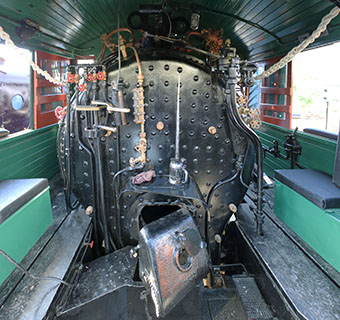
Above, a composite view of #27’s backhead. The engine appears to be in good condition but will probably never run again: its boiler flues have all been removed.
An oil burner, the engine weighs 121,000 lbs, 96,000 lbs on its 56" drivers. With a 22.4 sq ft grate, 146 sq ft firebox, total heating surface of 1,628 sq ft and 18" x 24" cylinders, it operated at a boiler pressure of 190 psi delivering 22,425 lbs tractive effort.
After its brief final stint in service, #27 was retired to the engine house in Reno on
3rd June 1950. In 1951, it returned to steam for the fifteen part Columbia Pictures movie serial Roar of the Iron Horse, featuring Virginia
Herrick and Jock O'Mahoney. The locomotive then went on display on Highway 395 on the north edge of Carson City with baggage car and combine #18. It moved to Carson City airport in 1963 and then, from 1971 until 1993, to Virginia City. After moving to the museum, it was restored for display as it appeared after its 1940 overhaul.
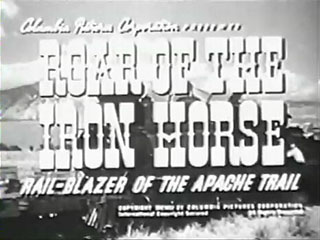

Above, #27 as it appeared in Roar of the Iron Horse. Note the balloon stack in the lower view. The curious, conical smokebox door also evident in this view does not appear in every shot of #27 in the series.
O'Mahony played Jim Grant, a railroad agent, who is hired to tackle a hardfaced villain played by George Eldred called "The Baron". With his band of henchmen, The Baron is trying to sabotage the building of the transcontinental railroad, including bribing the local Native American warriors to do his dirty work. The series was filmed entirely on and around the V&T.

Originally a coal burner, #25 was converted to burn oil in 1907. It has an 18.2 sq ft grate, 89.9 sq ft firebox and total heating surface of 1,069. Operating at a boiler pressure of 160 psi, it delivered 15,760 lbs tractive effort compared to #26 and #27’s 22,425 lbs. The 6,000 lb tender has a 3,000 gallon water capacity.
As traffic declined on the V&T in the early 1920s, the passenger-only service between Reno and Virginia City was replaced with a mixed service in 1924, although #26 and #27, rather than the less powerful #25, handled most of the runs.
#25 was the first of three Ten Wheeler (4-6-0) type locomotives rostered by the V&T.
It was built by Baldwin at a cost of $8,425 in 1905 to replace the V&T’s 4-4-0s like “Inyo” and the “Rhode Island”, the first #25, on passenger services between Reno and Virginia City, but it also hauled freight and mixed consists when required. At 90,000 lbs, it is 31,000 lbs lighter than the V&T’s other two Ten Wheelers, #26 and #27, which were delivered two years later (#27 is shown earlier on this page). At 70,000 lbs, it is also 16,000 lbs lighter on its drivers.
When the Carson City to Virginia City line was downgraded to a branch line in 1932, #25 became the regular engine on the line until 1938. That year, it hauled the last scheduled train on the branch line and, thereafter, saw little use except as a snowplow, as #18 “Dayton” had been retired and sold to Paramount Pictures for $1,000 that year. It received its final overhaul at Southern Pacific’s Sparks, NV, shops in 1943.
Like many other V&T locomotives, #25 was soon on its way to a career in Hollywood. In 1947, it was sold to RKO Pictures for $5,000 to raise money for a larger locomotive for the V&T, Nevada Copper Belt 2-8-0 #5.
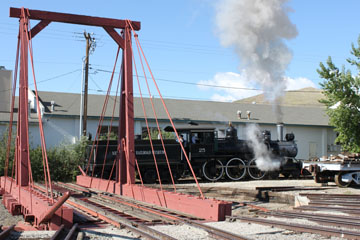
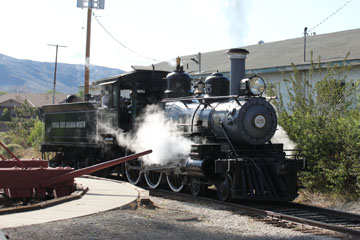
#25 appeared in three films in 1948, United Artists’ Four Faces West, starring Joel McRea and Frances Dee, RKO’s Return of the Badmen, with Randolph Scott and Anne Jefferys, and Metro-Goldwyn-Mayer’s Three Godfathers starring John Wayne and Pedro Armendariz. Over the next seven years, it featured in fourteen more movies, including 20th Century Fox’s Canadian Pacific, a convoluted and rather strained story set against the CPR’s construction of the railroad over the Canadian Rockies.
In 1971, the locomotive was bought by the State of Nevada and restoration work started at the museum. It returned to operation in 1980

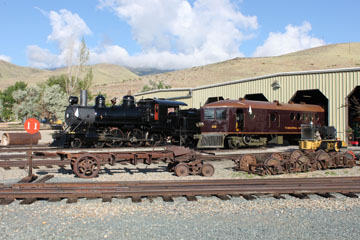
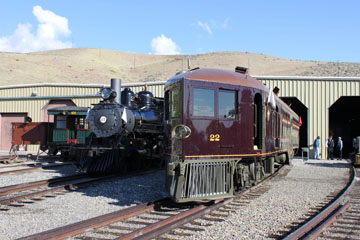
Above, #27 standing alongside V&T McKeen Motor Car #22.
This 70’ long motor car was bought in 1910 as a cheaper alternative than a steam locomotive for passenger service on the Carson City-Minden
line, soon extended to Reno. With reduced passenger service, the car was rebuilt by the V&T in 1932 to create space for more mail and express freight. It then returned to a daily Reno-Minden round trip until 31st October 1945. The following year, the body was sold and converted to Denny’s Diner at the corner of Carson and John Streets in Carson City, then to office space for Al’s Plumbing Supply.

William McKeen developed the McKeen Motor Car while working as Superintendent of Motive Power and Machinery at the Union Pacific. The first cars were built by the UP before he established the McKeen Motor Car Company and leased space in the UP's shops in Omaha, NE. One hundred and fifty-two cars were then produced between 1905 and 1917, all but nine for US customers, in 55’ and 70’ versions.
It was among the first gasoline-powered railroad engines and its sleek contours anticipated the streamline look of the 1930s. However, there were problems. Until a separate gasoline-driven compressor was introduced, starting the engines could be difficult as it relied on often limited reserves in the car's reservoirs. Transmission was also a problem and clutch failures were common. The lack of a reverse gear was another difficulty as the engine had to be stopped, the camshaft shifted to a set of reverse cams, and then started in the opposite direction.
Al’s Plumbing donated #22 to the museum in 1996, and work began to return it to operating condition. The restored car emerged on 9th May 2010, the hundredth anniversary of its construction, and it is currently the only operating McKeen Motor Car in existence.


This motor car was built at a cost of $10,465 in 1926 by the Edwards Railway Motor Car Co., in Sanford, NC, for the Tucson Cornelia & Gila Bend Railroad. The TC&GB was incorporated in 1915 and opened its line between the Phelps Dodge copper mine at Ajo, AZ, and a connection to the Southern Pacific at Gila Bend in 1916. As copper production declined in the 1970s and 1980s, however, the railroad ceased being profitable, and the line was closed in 1985.
#401 is typical of the small, gasoline powered cars, often known as “Doodlebugs”, used on many US shortlines and branch lines from the 1920s to the 1940s. It spent its entire life on the TC&GB. Taken out of service on 31st December 1947, it was retired in the early 1950s.
The TC&GB then donated the car to Travel Town in Los Angeles (there is a page with photos of Travel Town on this website). It was bought by Shortline Enterprises in the early 1970s and, repainted and relettered as V&T #50 “Washoe Zephyr”, it ran for a brief period on the V&T tourist line out of Virginia City, NV. It was then acquired by the museum, which returned it to its original number and livery in 1999.
#401 runs at weekends May-September when no steam train is operating.

Donations came from over six million French citizens and the result was a forty-nine box car "Merci Train" (Thank You Train). One box car was destined for each of the then forty-eight states, and one was to be shared between the District of Columbia, Alaska and Hawaii.
The steam ship Magellan transported the box cars to the US and arrived bearing a banner reading "MERCI AMERICA" on 3rd February 1949, with over 25,000 onlookers in attendance. The cars weighed a total of more than 250 tons and contained artwork, antiques and books.
Above, the Nevada “40 et 8" car, donated to the people of Nevada by the people of France.
In the aftermath of WWII in the winter of 1947-48, the US began a relief effort to war-torn France and Italy: citizens donated more than seven hundred box cars of goods, food and clothes to an "American Friendship Train". In gratitude, a group of French citizens led by the railroad worker and WWII veteran André Picard organised a private effort to thank the people of the US for their assistance in the two world wars and for the relief aid.
The cars were called "40 et 8" (40 and 8) as the French military rated them to carry forty soldiers or eight horses. P.H.M. J 58673 was built by the Chantiers de la Buire (Builders of the Buire) at an unknown date, and used by the Compagnie des Chemins de Fer Paris à Lyon et à la Méditerranée (Paris, Lyons & Mediterranean Railway). It arrived in Carson City on 23rd February 1949 where it was greeted with a ceremony and speeches.
You can see the Maryland “40 et 8” car on the B&O Museum Roundhouse page of this website, the Kentucky car on the Kentucky Railway Museum page and the Utah car on the Union Stataion Ogden page.

Along with #11, also in the museum’s collection, V&T #12 (below) was one of two ornately styled demonstration cars purchased for $2,500 and built by J. G. Brill & Co., in Philadelphia, PA, some time before 1874.
The coaches have a number of unique features, including their arched clerestory roofs bearing oval stained glass windows with cut floral
designs, the curved corners on their two ends, the solid wood side bracing and four inches of sawdust beneath the floor to provide sound insulation.
Above, V&T #17 above is the oldest passenger car in the museum’s collection.
The coach was built in 1868 by the Central Pacific in Sacramento, CA, as a private car for company officials, and research suggests it was the coach that transported Leland Stanford, Central Pacific officials and the golden spike to Promontory, UT, for celebration of completion of the transcontinental railway in May 1869 (you can see
a page devoted to the Golden Spike NHS on this website). It was then Construction Supervisor Charles Crocker’s private car for several years
after he became Superintendent of the Central Pacific.
The V&T bought the coach in 1875 for $2,500 for use by V&T Superintendent Henry M. Yerington and President William Sharon, US Senator for Nevada, when it was renumbered #25 and named “Bonanza”. Three years later, the coach was remodelled for passenger use and renumbered
#17. It remained in service for sixty years before being sold to 20th Century Fox in 1939 for use in film making. In 1971, #17 was sold to Short Line Enterprises for continued service in films. Finally, the museum purchased it in 1988. #17 was
housed in the museum’s engine house awaiting restoration when I visited.
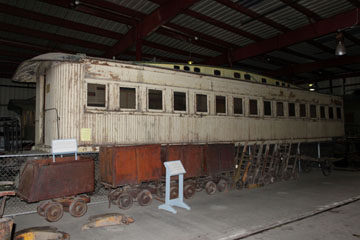
Inside, the coaches have light oak panelling and are divided into two compartments, one designated for smoking.
These comparatively heavy cars were used on V&T express passenger services for a few years but were then relegated to secondary and picnic train services. They were sold to Paramount Pictures in 1938 for $500 each and, the following year, appeared in Cecil B. DeMille's Union Pacific, the release of which coincided with the 70th anniversary of the driving of the golden spike at Promontory, UT. After featuring in many other films, they returned to Carson City in 1971 and were awaiting restoration when I visited.


There are several maintenance of way vehicles on display in the engine house. Above is a late 19th Century classic hand operated car.
The motorised example below, VT Track Speeder #12, is more typical of vehicles from the early/mid 20th Century.

These vehicles were used to carry crews and their tools to work on sections of the railway, as well as carrying officials to inspect portions of the track.
Built in the 1920s, the V&T replaced #12 in 1931 with a more up to date model. It was bought by the museum in 2003.
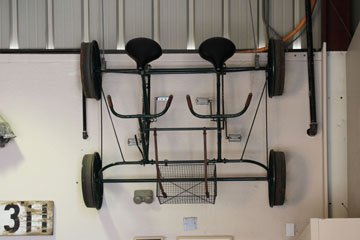
Less typical of these maintenance of way
vehicles, but not unique, is the Track Bicycle above.
This pedicycle was built by the Light Inspection Car Company of Hagerstown, IN. It was used for many years by V&T employee Enrico Guiffra.
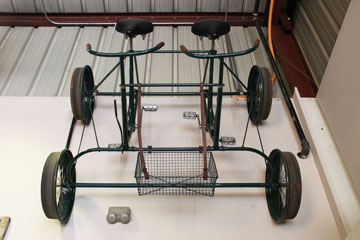
The pedicycle was also used by Enrico's wife, Clara.
She carried her baby son, Albert, in the front wire basket pedalling up the long grade from where the family lived near American Flat to pick up mail and shop at the nearest grocery store in Gold Hill!

The engine weighs 81,000 lbs, 62,000 lbs
on its 44” drivers. It has an 11.8 sq ft grate,
70 sq ft firebox and total heating surface of 1,210 sq ft. An oil burner operating at a
boiler pressure of 180 psi, with 16” x 20” cylinders, it delivered 17,804 lbs tractive effort.
Below, #8 appeared in the 1948 Hopalong Cassidy movie Sinister Journey starring William Boyd, Andy Clyde and Rand Brooks. It retired and was presented to the State of Nevada in 1955.
Narrow gauge (36”) Southern Pacific T-44 #8 is owned by the museum but is on loan to the
City of Sparks, NV, and is on display in an enclosed area on Victoria Ave.
The engine was built in 1907 by Burnham, Williams & Co., an early incarnation of the Baldwin Locomotive Works for the Nevada-California-Oregon Railroad.
The railroad eventually laid and operated over two hundred and thirty-eight miles of track from Reno, NV, to Lakeview, OR.
It was taken over by the Southern Pacific in 1926 and quickly converted to standard gauge. Most of the narrow gauge equipment was sold, but #8 survived the cut, assigned to mixed freight and passenger trains on track that was once part of the Carson & Colorado, working until 1955.
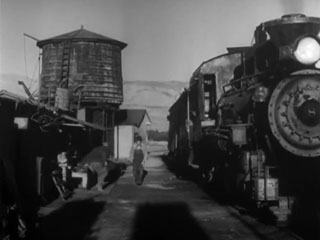
Related Links:
Location of the Nevada State Railroad Museum, Carson City
Friends of the Nevada State Railroad Museum
Virginia & Truckee Railroad Website
Send a comment or query, or request permission to re-use an image.
The museum has published an Equipment Guidebook, which gives details of the museum's motive power and rolling stock (click on the cover to search for this book on Bookfinder.com).
